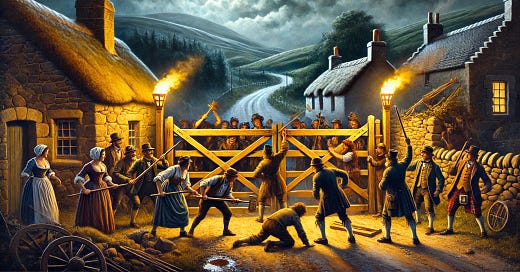Scotland’s rugged landscapes and tight-knit rural communities have long been celebrated in history and folklore. Yet, beneath the romanticized image of rolling hills and Highland villages lies a tale of tension and rebellion—a unique tax revolt centered on road tolls that gripped rural Scotland in the late 18th and early 19th centuries. While taxation resistance is a familiar theme in history, the Scottish peasant revolt against tolls stands out for its grassroots fervor and the unintended consequences of infrastructure modernization.
The Toll Boom and Its Discontents
By the mid-18th century, Scotland’s economy was evolving rapidly. Agricultural improvements and burgeoning trade made the need for better transportation networks clear. The turnpike roads, financed through tolls collected from road users, became the solution. Parliament authorized the establishment of turnpike trusts, organizations responsible for maintaining roads and collecting toll fees from travelers. These toll gates, known colloquially as "pikes," began to spring up across the countryside.
The concept was practical on paper: travelers paid for the privilege of using better-maintained roads, enabling farmers to transport goods more efficiently and traders to expand their reach. However, for many rural Scots, the tolls were an unbearable burden. Already struggling under economic pressures, the peasants saw the toll gates as symbols of an unjust system that disproportionately taxed the poor while benefiting wealthier landowners and merchants.
The Roots of Resistance
Discontent simmered for years before erupting into outright rebellion. The spark was not just the financial strain but the perceived unfairness of the toll system. Many tolls were placed on frequently traveled rural roads, forcing impoverished farmers and laborers to pay even for short, routine trips to markets, mills, or neighboring villages. For those living hand-to-mouth, every penny counted, and the tolls became a flashpoint for broader grievances about inequality and governance.
The resistance took on a distinctly communal character. Small acts of defiance, such as evading toll gates or tampering with toll records, were common. But over time, these isolated incidents coalesced into more organized protests. Groups of peasants began gathering to dismantle toll gates, blocking roads and harassing toll collectors. These actions, dubbed "toll riots," were particularly intense in areas like Perthshire, Fife, and Dumfries.
The Toll Riots: Resistance in Action
The toll riots reached their peak in the early 19th century. One of the most famous incidents occurred in the village of Kirkintilloch, near Glasgow, where locals, incensed by the imposition of a new toll, organized a dramatic nighttime raid. A mob of villagers, armed with tools and torches, descended on the toll gate, dismantled it, and carted away the timber. Despite efforts to prosecute the leaders, the community closed ranks, frustrating authorities and creating an enduring symbol of collective defiance.
Another notable riot erupted in the Borders town of Jedburgh, where the imposition of tolls on previously free local roads was met with outright rebellion. Women and children were often active participants, emphasizing the deep communal stakes. In some cases, the protests turned violent, with clashes between toll collectors, backed by local authorities, and protesters wielding whatever tools they could find.
The authorities responded by dispatching troops and police to quell the unrest, but the sheer scale and grassroots nature of the resistance made enforcement difficult. Dismantled gates were often rebuilt, only to be destroyed again in the dead of night. Local communities frequently protected the identities of rioters, complicating efforts to impose penalties.
The Consequences and Legacy
The peasant resistance to road tolls forced the government and turnpike trusts to confront the inefficiencies and inequities of the system. While the riots themselves were not revolutionary in their aims—they sought relief from a specific burden rather than systemic change—they highlighted the growing disconnect between rural communities and a governance structure perceived as indifferent to their struggles.
By the mid-19th century, changes in transportation technology and public policy rendered the toll system increasingly obsolete. Railroads became the dominant mode of transportation, reducing the importance of toll roads. Public pressure also led to reforms that eventually saw the abolition of turnpike trusts, with road maintenance funded through general taxation rather than user fees.
The toll riots hold an important place in Scotland’s social history. They serve as a reminder of the power of collective action and the ways in which ordinary people can resist perceived injustices, even when faced with the might of the state. These events also reflect a recurring theme in history: the tension between progress and the unintended hardships it imposes on vulnerable populations.
Lessons for Today
The toll riots of rural Scotland resonate in contemporary discussions about infrastructure, taxation, and inequality. As governments and municipalities grapple with the challenges of funding public works, the tension between efficiency and equity remains as relevant as ever. Whether it’s congestion pricing in urban areas or debates over toll roads and bridges, the lessons of 18th-century Scotland remind us that infrastructure projects must be designed with fairness and inclusivity in mind.





